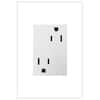Jay Ashworth
Well-Known Member
I thought we'd been one of the places, already, where the apparently never-ending conversation about whether you should mount your grounded receptacles "upside down" had happened -- putting the ground pin on top, rather than the bottom.
I'm fairly sure there's no NEC requirement either way -- though I'm sure we have some folks here who could quote chapter and verse... but I note that both large theatre buildings I've been working in built in the last 5 years are pin up on 5-15R's, and I note that many 5-15 right angle plugs/cords of recent manufacture -- and nearly all right angle plugs in larger ampacities -- expect the grounding pin on the top as well, if they are not adjustable.
I am a pin-up guy, for what seem to me to be good and sufficient reasons about shorting duration if something gets on the pins, but I would like to hear about it if anyone knows about *regulatory* findings on this point, NEC, NEMA, State or local.
I'm fairly sure there's no NEC requirement either way -- though I'm sure we have some folks here who could quote chapter and verse... but I note that both large theatre buildings I've been working in built in the last 5 years are pin up on 5-15R's, and I note that many 5-15 right angle plugs/cords of recent manufacture -- and nearly all right angle plugs in larger ampacities -- expect the grounding pin on the top as well, if they are not adjustable.
I am a pin-up guy, for what seem to me to be good and sufficient reasons about shorting duration if something gets on the pins, but I would like to hear about it if anyone knows about *regulatory* findings on this point, NEC, NEMA, State or local.
Last edited:



